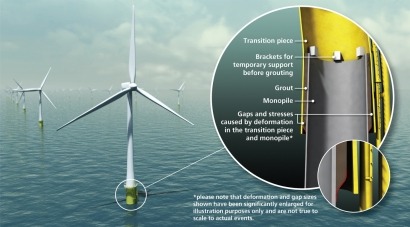
Offshore wind is an emerging industry. With stronger and more consistent wind speeds than onshore wind farms, it is being increasingly explored all over the world for its high yield. In 2010, the cumulative installed capacity for offshore wind, across the world, stood at 3.1 GW, contributing around 1.6% of the total wind power capacity.
However, the offshore wind industry is currently facing a number of challenges, including availability of skilled personnel, a lack of appropriate technology catering to offshore requirements, shortage of appropriate auxiliary services, incompatibility with existing grid infrastructure, insufficient integration into the energy system, and competition for space with other industries such as telecoms and oil and gas.
Grouting failure
One of the most important technical challenges being faced by many European offshore wind farm developers first came to light in April 2010, when a design fault in grouting used to fix wind turbines to their monopiles or towers was discovered.
Due to this design fault, the grout injected during the installation of offshore wind farms is breaking up, which has shifted the turbines on their monopile foundations. Research and Markets reveals that as per industry estimates, around 600 of Europe's installed offshore wind turbines are facing the issue of dissolved grouting.
At the time, wind farm developers such as Dong Energy and turbine makers such as Vattenfall said that they were looking into the problem, but declined to comment on how long the inspection would take or how much the solution might potentially cost. It was deemed by industry executives at the time as an industry-wide problem related to a general design and not one particular tower model.
Conical-shaped connections
In February 2011, new guidance aimed at combatting the grout failure was published including the use of conical-shaped connections for fixing the turbines to their monopiles.
The new guidance came in time for much of the Round 2 offshore wind construction in the UK with the Lincs wind farm off the English east coast, for example, among the first to adopt the conical connection developed by DNV as a result of a joint industry project (JIP) with key industry players including RWE Innogy, Statoil, Statkraft and Vattenfall Vindkraft.
The JIP concluded that a cylindrical-shaped design of grouted connections without additional support arrangements for axial load is not recommended. The main reasons for this are that the axial capacity is found to be lower than that previously assumed due to the effect of large diameters, the lack of control of tolerances that contribute to the axial capacity, and the abrasive wear of the grout due to the sliding of contact surfaces when subjected to large bending movements from wind and waves.
Based on the JIP, a design practise to account for large dynamic bending moments on monopiles was developed using conical-shaped connections. According to this, the monopile and transition piece are fabricated with a small cone angle in the grouted section as shown in the inset.
If the bonds between the steel and grout are broken during in-service life, some slight settlement of the transition piece will occur. This settlement will introduce compressive contact stresses between the steel and grout which, together with some friction, will provide sufficient resistance against further settlement.
Grouted connections with shear keys
The knowledge gleaned from the JIP is also expected to influence the design of large diameter grouted connections with shear keys. Shear keys are
circumferential weld beads on the outside of the monopile and the inside of the transition piece in the grouted section. The shear keys’ purpose is to increase the sliding resistance between the grout and steel so that no settlement occurs. The existing design standards for such connections are based on limited test data for alternating dynamic loading.
Before this solution can be recommended though, design practises for shear keys should be developed and properly incorporated in design standards. DNV has therefore initiated a complementary JIP with the aim of updating existing knowledge of and design practices for grouted connections with shear keys.
Bearing up to offshore stresses
Where cylindrical-shaped grouted connections are already used offshore and where the design is such that settlement may be expected, the JIP concluded that “additional support arrangements should be considered for the transfer of axial loads”. DNV reports that such mitigation methods for existing installations have been developed and are already implemented on several structures.
The global industrial group specialising in advanced polymer technology, Trelleborg, for example is offering alternative solutions to the grouting issue, having developed an elastomeric spring bearing that has improved the stability of the 90-monopole wind turbine foundations at a wind farm off the UK coast. The steel and rubber bearings reduce stress on a grouted connection in the wind turbine foundation.
The industry is clearly making progress tackling this challenge, the question now is to what extent the estimated €28.71 million bill for re-strengthening the affected wind turbines will impact on the industry.
For additional information:

